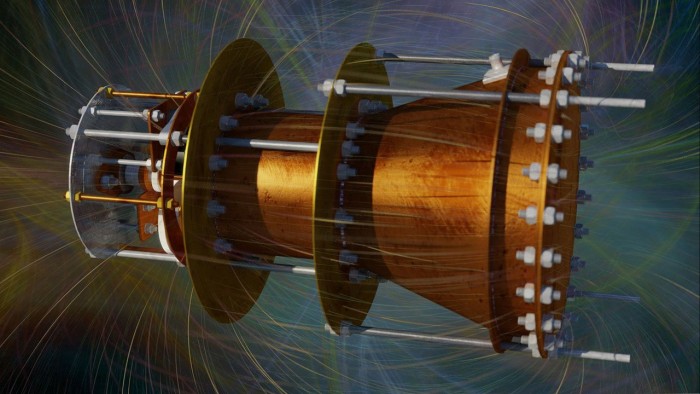
The mystique surrounding the EmDrive as a feasible and efficient space engine is slowly falling away. It is an engine that works, in theory, without combustible fuel and could take a spacecraft to the Moon within a few hours.
The EmDrive can be summarised as a propellantless propulsion system. The defining quality of the engine is that it works as a kind of microwave oven, generating energy without igniting liquid fuel (which is how current jet engines work). It is sometimes referred to as a ‘radio frequency resonant cavity thruster’. The EmDrive’s design works by having a magnetron drive microwaves into a closed conical chamber which is then pushed back from the opposite end of the cone. The resulting force propels the machine forward.
If we accept the premise of a fully operational EmDrive, the technology holds many substantial benefits. A spacecraft that is fitted with EmDrive thrusters could reach distant parts of our solar system much more quickly than current technology. It would revolutionise the design of rockets, no longer having to drag massive fuel tanks along for the trip. Spacecrafts would immediately become cheaper, easier to manufacture and crucially, much lighter.
The problem with the EmDrive (a thorn that has hindered its development since genesis) is that the concept of ‘reactionless’ drive flies squarely in the face of Isaac Newton’s observed law of conservation of momentum.
Newton declared that an object will not move unless an exterior force is applied to it. Yet, somehow, the EmDrive shows potential to perform this action without needing an equal expulsion of energy to set it in motion. For the EmDrive to be deemed a total success, it would mean either an as-yet-unidentified phenomenon occurs in physics or that the human understanding of the subject is fundamentally flawed. Despite scepticism since its inception in 2001 by aerospace engineer Roger Shawyer, the EmDrive has continued to draw interest.
In 2015, an independent research group of NASA, Eagleworks, took a crack at the design. Their tests rectified several errors of previous EmDrive versions and reportedly achieved force smoothly. It is their paper (“Measurement of Impulsive Thrust From a Closed Radio Frequency Cavity in Vacuum”) that has passed the peer-review process and will be published.
The viability of the EmDrive is not yet certain as no research group has reported a large margin of power from the machine. It is the mysterious nature by which the EmDrive apparently achieves small amounts of force that keep some scientists hopeful.
A theory was put forth in 2016 by physicist Michael McCulloch regarding the cause of the EmDrive’s enigmatic (yet minuscule) thrust. The Professor of Plymouth University speculates an answer that utilises the Unruh effect and inertia. The Unruh effect is an unconfirmed theory that describes the formation of particles out of a spatial vacuum due to the observable heating that occurs in the universe because of physical acceleration. McCulloch’s complete treatise of the concept can be found here.
But many voices in the scientific community remain dismissive. Corey S. Powell of Discover Magazine wrote a lengthy critique on Shawyer’s EmDrive and the enthusiasm surrounding NASA’s involvement with the technology, which he regards as misleading. Similarly, mathematical physicist Professor John Baez denounced Shawyer’s EmDrive claims in 2014, stating that: “It's like sitting inside a car and making it roll forwards by pushing on the steering wheel. Standard physics doesn't allow this. He didn't claim to be using anything other than standard physics.”
Though the scientific community remains largely divided on the subject, the publication of Eagleworks’ paper on the EmDrive should shed more light on the engine’s potential and spur on further enquiry, experiments and research into propellantless propulsion. NASA’s Eagleworks group is set to publish research on the technology behind the EmDrive in the AIAA Journal of Propulsion and Power.
That their findings will be published in a reputable journal means that other scientists will have access to the engine’s inner workings for further advancement. The paper will allow others to duplicate the machine and devote greater resources to its trials and refinement.






